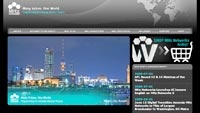MHz Networks establishes digital niche with unique content

About a month ago, when the majority of commercial television broadcasters across the nation turned off analog broadcasting, many stations faced an uncertain future due to a failing economy, diminished advertising and increased competition for viewers.
However — for one small network serving the Washington, D.C. market — taking a risk with digital technology and creating a unique programming lineup turned into a major boon. Since June 12, MHz Networks, owned by Richmond, VA’s Commonwealth Public Broadcasting, has become the largest broadcaster in its market.
With a unique programming lineup, viewers can now watch 10 international television channels in 20 languages from MHz Networks — all free of charge. The network has acquired a footprint of more than 27 million households through over-the-air broadcast, cable and satellite carriage.
The story of MHz Networks is one of how innovative thinking backed by a smart bet on digital technology paid off. It contrasts with stations that continue to operate the same way after the digital transition.
On March 1, 1972, WNVT-TV signed on Channel 53 as an independent public broadcasting station. On June 6, 1981 Channel 56 signed on as WIAH and, in 1982, changed its call letters to WNVC. The two stations were operated from the same northern Virginia studios, and were run as sister stations.
In 2001, the two stations became known as MHz Networks, with WNVC becoming MHz and WNVT becoming MHz2. In 2003, WNVT ceased analog broadcasting and went digital-only on channel 30.
On Sept. 1, 2008, WNVC ceased broadcasting in analog permanently and went off the air to perform technical modifications that included installing a digital antenna and boosting the station’s power. It returned to air June 12 on channel 24.
The professional video industry's #1 source for news, trends and product and tech information. Sign up below.
However, it was in 1993, with the arrival of Frederick Thomas as programming manager (now CEO), that a plan was devised that would eventually put the broadcasters on the map. At the time, the two stations were airing a hodgepodge of programs on a random schedule. Thomas studied the results of the then new 1990 census and noted the D.C. market had a large number of ethnic citizens.
In response to the census data, he began programming to the diversity of the market. Starting off modestly with 10 foreign films, Thomas slowly acquired the rights to programs from foreign news services. He quickly learned there was an international underbelly to the nation’s capital.
For the past 15 years, the station has aired international programming including newscasts from Moscow, La Piovra, the Mafia mystery series from Italy, the seminal German detective series, “Tatort” and “Water Rats,” TVB’s all-time favorite crime procedural based on the Sydney Water Police in Australia’s great natural harbor. MHz is different from many international channels because it’s neither language-based, nor does it focus on a single culture or region.
With the transition to digital broadcasting, Thomas again decided to take another risk and to think different from other broadcasters. In 2003, when few viewers even knew of the digital transition, WNVT became the first noncommercial “digital-only” broadcast channel in the country.
Working with Comcast, Cox and Verizon FiOS, MHz Networks acquired pay-TV carriage for its programming. It was able to provide its digital broadcast channels nearly two years before most viewers were aware that those same channels were available for free over-the-air.
Many analog viewers without pay-TV service thought the stations were off the air. Then came June 12, when these same viewers were surprised to find that MHz Networks had unveiled its new 10-channel lineup on channels 30.1-30.10. Ratings boomed.
Five of the network’s channels, including programs from the Middle East, China and Japan, are aired from a 698ft tower in Falls Church, VA. The remaining five channels with programs from Vietnam, France and South Africa are aired from a tower in Prince William County. Studio facilities are located in Falls Church and at Washington, D.C.’s Ronald Reagan Building and International Trade Center.
Starting next month, MHz Networks will begin airing mobile video broadcasts in the D.C. area as part of a pilot project by the Open Mobile Video Coalition. However, there won’t be many viewers because handsets capable of receiving the new mobile video broadcasts aren’t available to consumers. Broadcasters hope such handsets will become available next year.
